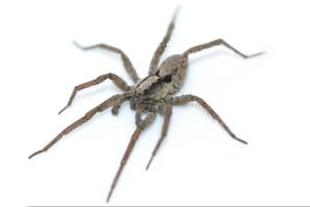 Purring spider (Image: Alex Sweger/University of Cincinnati) Purring spider (Image: Alex Sweger/University of Cincinnati)
The purring wolf spider, it's music. For the first time, a spider has been recorded producing what appear to be audible courtship signals over and above pure vibrations. Many spider species rely heavily on vibrations to send signals to one another, by shaking leaves or strands of their webs.
Uetz and Sweger found that males produce the sound and only females respond to a played recording of the purr, suggesting that the purr is used in courtship. The males only produce the sounds if they are standing on something that will vibrate, like a leaf, and females only respond when perched on a similar surface. They think that the signal reaches the female by travelling as sound in air, which causes the leaves a female is standing on to vibrate. The purring spiders may help us better understand how communication by sound first evolved. Their findings were reported today at the annual meeting of the Acoustical Society of America in Pittsburgh, Pennsylvania. Sorce: newscientist.com El ronroneo de la araña lobo, es música. Por primera vez, una araña ha sido registrada produciendo lo que parece ser señales de cortejo audibles por encima de puras vibraciones. Muchas especies de arañas dependen en gran medida las vibraciones para enviar señales a la otra, por agitación de hojas o hebras de sus telas. Uetz y Sweger encontraron que los machos producen el sonido y sólo las hembras responden al ronroneo, lo que sugiere que el ronroneo se utiliza en el cortejo. Los machos sólo producen los sonidos si están de pie sobre algo que va a vibrar, como una hoja, y las hembras sólo responden cuando están paradas en una superficie similar. Ellos piensan que la señal llega a la hembra viajando como sonido en el aire, lo que provoca que la hoja donde se encuentra parade la hembra vibre. El ronroneo de estas arañas pueden ayudarnos a entender mejor cómo la comunicación por sonido evolucionó. Sus resultados fueron publicados hoy en la reunión anual de la Sociedad Americana de Acústica en Pittsburgh, Pennsylvania. Fuente: newscientist.com Click here to listen to the spider
0 Comments
Leave a Reply. |
Blog Archive
|
 RSS Feed
RSS Feed
